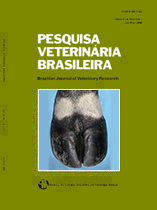 |
|
|
|
Year 2015 - Volume 35, Number 4
|

|
Electrocardiographic study of the Creole breed mares, 35(4):319-323
|
ABSTRACT.- Pascon J.P.E., Santos F.P., Pereira D.T.P., Mistieri M.L.A. & Mozzaquatro F.D. 2015. [Electrocardiographic study of the Creole breed mares.] Estudo eletrocardiográfico de éguas da raça Crioula. Pesquisa Veterinária Brasileira 35(4):319-323. Serviço de Cardiologia Veterinária, Curso de Medicina Veterinária, Universidade Federal do Pampa, Rodovia BR-472 Km 592, Uruguaiana, RS 97500-970, Brazil. E-mail: joaopascon@unipampa.edu.br
The electrocardiography is an indispensable diagnostic tool to detect heart arrhythmias and electrical conductions disturbances in equines, as well as on prognosis determination of heart diseases, athletical performance, efficiency of training, and on electrolytic disturbance evaluation. However, electrocardiographic variables can be influenced by several factors such as age, gender, breed and phenotypic characteristics. Therefore the establishment of the characteristics of normality for different breed and phases of development is fundamental. Creole breed were firstly introduced to the American continent more than four centuries ago and it descends from horses of Iberian Peninsula. The breed is a result of natural selection that configured resistance and unique physical attributes. The present study aimed to analyze and compare the electrocardiographic parameters of Creole females in different ages, and verify the possibly influence of pregnancy on it. Digital electrocardiographic evaluation on apex-base lead was performed on 84 healthy creole mares (34 pregnant and 50 non-pregnant). The electrocardiograms were divided in groups concerning the age as G1 (until 4 years old), G2 (from 5 to 9 years old) and G3 (over 10 years old). No physiological or pathological heart arrhythmias and electrical conduction disturbances were seen in all examined mares. Sinus tachycardia , bifid P waves, rS configuration of QRS and biphasic T waves were the predominant patterns in all evaluated groups. Only the average of QRS duration of G1 females was significant superior (110,65±8,49) (p=0,0002) when compared with G2 (101,98±10,02) and G3 (100,92±10,72). The autonomic variables (ITV, average NN and SDNN) were lower in pregnant mares comparing to non-pregnant mares, suggesting a greater sympathetic autonomic system tonus and/or decrease of parasympathetic tonus on pregnant mares. In conclusion, the age affect only the QRS duration, and the pregnant condition was capable to decrease the time domain heart rate variability indexes with maybe influence the electrocardiographic evaluation of enrolled Creole mares. |
| |
|
|
| |
|
 |